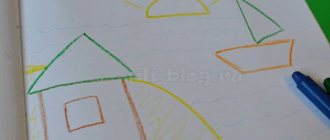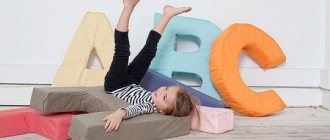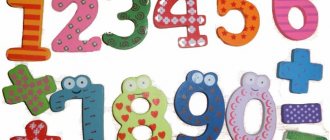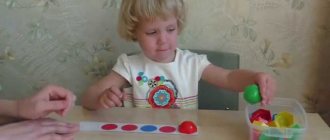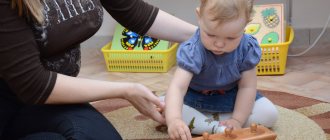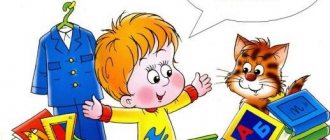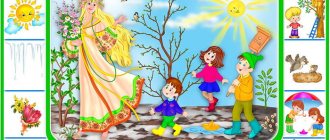Content:
- Learning letters: where to start? Is your child ready to learn the alphabet?
- Advice from psychologists
- 3-4 years
- Game techniques
- A brief overview of modern primers
Electronic poster “Talking ABC”
The educational sound poster is a great addition to standard alphabet learning techniques.
It combines visual and audio perception, allowing you to learn the letters and sounds of the alphabet, as well as numbers from 1 to 33. The poster features several modes - song, riddle or task, which allows you to diversify the learning process.
The posters differ in sound and pronunciation principles. It is recommended to choose those where there is a pronunciation of letters as sounds.
Learning the alphabet is an important step in the life of every child, which will allow them to gain new knowledge and analyze it. It is worth treating this period with patience and helping your child learn through a playful approach and support.
Learning letters: where to start?
Photo source – www.freepik.com
Before teaching your child letters, you need to decide: 1) whether he is ready to learn, and 2) what goal you are pursuing. If the reason lies in the parents’ desire for the child to know as much as possible in order to show off to others, it is better to leave this idea. The young student himself must show an interest in knowledge and want to learn the alphabet. You need to concentrate on his desires and abilities.
If parents see that their child is inquisitive and shows interest in new knowledge, this is a signal that they can start learning letters. It is important to remember that any theory must be supported by practice. Having learned the letters, proceed to syllables, and then gradually move on to reading.
The main task of parents is to be patient and convey information in an accessible form, and also not to force the child to study if he does not want to. It is better to conduct classes in the form of a game.
You need to start training only if the child himself wants it, or if he will soon go to school. According to the requirements of educational institutions, when entering school, children must know the basics - letters, numbers. Without these basic skills, studying will be much more difficult.
Is your child ready to learn the alphabet?
To determine how ready the baby is, there are psychological tests. Parents are asked to answer yes or no to the following questions:
Development of cognition
- Does the child understand such judgments - right/left, much/little, big/small, low/high, near/far, under/above.
- Can understand simple situations in which it is necessary to divide objects according to classification. For example, identify a group of green and red objects.
- Is he able to think of the end of a fairy tale or story?
- Does he consistently fulfill three requests, without reminding his parents?
Basic knowledge
- Has the child ever been to a post office, a store, or a zoo? How broad his horizons are.
- Have you visited the library?
- Did his parents read fairy tales to him, starting from a very early age?
Speech development
- Is it easy for the child to name the objects that surround him?
- Is it easy to answer the questions asked?
- Is he able to tell the purpose of household things - a vacuum cleaner, an iron, a refrigerator.
- Can he determine the location of objects - on, under, inside, near.
- How clearly does he pronounce words?
- Can he conduct a dialogue?
Development of the emotional sphere
- Is the child having fun with friends and communicating with family?
- Can he adapt to new changes in his daily routine?
- Knows how to compete and cooperate with friends.
Communication level
- Can he share toys and communicate with other children?
- Knows how to listen to others and not interrupt.
Level of physical development
- Is the child diligent, is he able or not to sit quietly for a certain period of time?
- Plays with the ball, jumps, goes down and up the stairs.
- Gets enough sleep, has a good appetite, and knows how to extinguish emotional outbursts.
Development of visual abilities
- Can a child distinguish between similar and dissimilar and classify them into separate groups?
- Distinguishes short words and syllables with similar sounds - forest/weight, cat/year.
- Able to notice changes - if three pictures were shown at first, and then one was removed.
- He knows how to spell his name, what at least three letters from the alphabet look like.
- According to the instructions of an adult, he is able to lay out pictures on the table.
- Knows the order of reading words - from left to right.
- Folds the minimum number of puzzles - from 10.
Hearing development
- Rhymes words.
- Repeats words and numbers after adults.
- Understands that words that are similar in pronunciation have different sounds.
- Retells what he heard.
Interest in reading
- Enjoys looking at the pictures.
- Loves to listen to fairy tales.
- Interested in letters.
Thinking about learning the alphabet in preparation for school? Find out how many words per minute a preschooler and primary school child should read and for what “grade”.
If parents can answer affirmatively to at least 50% of the questions proposed, they can safely offer their child to study the alphabet.
Advice from psychologists
To learn the alphabet with your child, speech therapists and psychologists recommend following these tips:
- do not teach letters strictly in alphabetical order;
- do not learn all the letters mixed together;
- first learn vowels, then consonants;
- name the sound, not the spelling of the letter (incorrect - BE, DE, correct - B, D);
- consolidate what has been learned with practice - show how to write, give the child the opportunity to write with chalk, paints, or with his finger on the cereal.
"Find it!"
Find all the letters “K” in this picture and circle them!
And in this picture there are all the letters “T”:
Find all the red letters “M”... And now the blue ones... And now the orange ones, etc.
Now count - how many letters “M” did you find in total?
Methods for studying vowels/consonants
To teach your baby letters, you need to be patient. You should not demand too much, otherwise he will lose interest in knowledge.
First, talk about each vowel letter separately. For example, the letter A. Name it, show how it looks in writing, how to write it. Next, name the words in which it is present. Show pictures that depict objects, people and animals whose names contain the letter A. Next, invite the child to independently remember words that also contain this letter. You can consolidate the theory with practice - while walking, pay attention to store signs, together with your child, try to find a letter that is already familiar to him.
After the previous sound has been learned, you can proceed to the next one. To captivate the baby, it is recommended to purchase cards with letters, a board, cubes, bright pictures and books.
⠀
When vowels have been studied and reinforced in practice, you can begin to master consonants. First, introduce the child to the sound, then show him the letters. Learn the sound D, not the letter DE . Otherwise, he will experience disorientation in the process of combining syllables into words. The method of studying consonants does not differ from the method of vowels. It is important to practice as often as possible, to remember together words that contain the learned letter. Sequence of actions, repetition of learned material, patience - this is what will help parents.
Let's sculpt.
A very useful activity is to sculpt letters from colored dough or plasticine. And if you combine sculpting with listening to Ekaterina Zheleznova’s songs from the album “Musical Primer” (in which the whole sculpting process is “sung” in a very interesting way), then sculpting will be even more fun.
Wonderful mothers, passionate about the development of children, have long made funny videos from these songs and posted them online.
For example, while playing and watching a funny video, you can make the letter A in a fun and interesting way:
Tilt two sticks
Connect at the top
One crossbar -
Like a letter A tent!
How to learn the alphabet - adapt to the child’s age
3-4 years
To quickly teach a 3-4 year old child, you need to start with simple letters (those that are most often used in speech). After this, gradually move on to complex and rarer ones. This way he will remember the words better and faster.
You only need to learn one letter per lesson. You shouldn’t conduct “lessons” every day - it’s better to do it at intervals of two to three days.
Secure the result using cards, cut out letters from paper or fabric, sculpt from plasticine or dough. Each time before a new sound, repeat the material covered. At 3 years old, a child will be interested in listening to and learning a funny song or rhyme with the alphabet.
At this age, there is no need to force or rush the child. School is not soon yet, quick preparation for it is not required. Conduct classes only at the request of the baby.
It is important to consider the following points when teaching three-year-olds:
- do not expect your child to learn the alphabet quickly (be patient and devote time to studying regularly);
- do not exercise for more than 7 minutes a day;
- learn letters in pairs - A-Z, U-Y;
- do not proceed to study consonants without vowels;
- Remember that at this age imaginative thinking plays a big role, so you need to purchase bright books, toys and pictures.
It’s easier to conduct classes with a four-year-old. At this age, children have more developed processes of perception and analysis of abstract information. You can add puzzles, magnetic letters, cubes to the pictures, attract fairy tales, rhymes, stickers, posters. For better memorization, name the letters and write them immediately, encourage the child to draw them with a pen, pencil, or chalk.
Try an interesting and quite effective technique: forming letters from simple improvised means - buttons, sticks, sand.
You can learn the alphabet with a four-year-old child through the following games:
- cut out letters from paper, and then choose at random and name them;
- show pictures of animals, things, etc., and ask what letter the depicted object begins with;
- learn rhymes and songs with the studied sounds.
5-6 years
5-6 years is the most optimal age for teaching a child the alphabet, and as a result, reading. He must speak and pronounce sounds correctly. If you have difficulties with this, you should visit a speech therapist. At this age, activities cease to be purely playful in nature. The child needs to be told why he needs to know the alphabet. For example, say that now he will be able to read books on his own.
Advice to parents. Five-year-olds can be offered special educational books and notebooks. For example, you should take a closer look at game books with puzzles, mazes, crosswords and other interesting tasks.
⠀
Parents of preschoolers can purchase copybooks in which children will perform various educational tasks. A good option is “First words. Recipes for preschoolers. With tasks. 5-6 years” – publication authored by S.V. Petrenko. This manual is not overloaded with exercises; the words are given in enlarged form. Plus, after completing the task, the child is asked to independently evaluate his work (circle the sun with the appropriate rating) - this will allow the child to feel what it is like to be a schoolchild.
For training, you can use the methods of 4-year-olds (section above). But increase the study time (make the process longer), study every other day and be more persistent. You can also use educational cards and pictures. Assemble letters from puzzles and cut-out parts, sculpt and draw. At this age, a child will be interested in playing with a ball - throw him a ball and say any word, and let him throw the ball back and say the first letter of this word.
After learning vowels and consonants, show your five-year-old how to form syllables.
⠀
The educational material includes cards with syllables that make up words. Before you begin directly teaching your child to add syllables, it is recommended to select several games and exercises with letters. The adult shows the child two cards with letters: a vowel and a consonant, where one letter follows the other, while the parent or teacher pronounces how a syllable is formed from them. For example, the letter L runs towards the letter A, resulting in the syllable “l-l-l-a-a-a”.
An example of a game that helps a child learn syllables
To play you will need scissors, paper and pencils.
The point: the child is asked to draw a car or a house with a window. Make cuts along the side edges of the window. Prepare a paper tape, place the vowels on it: A, O, E, Y, U, I, E, Z (keep in mind that the width of the tape should fit into the cuts on the window). Then glue a transparent pocket - it will be located directly in front of the window (a piece of polyethylene is suitable for this purpose). In this pocket, place the consonant letter L, N, M one by one (choose the simplest letters), then insert a ribbon with moving vowels into the window, stretch it out, showing the child how to form syllables.
7 years
Preschoolers are taught letters using elements of classical classes - books, primers, alphabet, and copybooks. The child needs to be taught not only to pronounce sounds, but also to represent letters in writing. The purpose of the lessons is not only the alphabet, but also learning to organize your own time. The child learns to do homework according to a schedule, at the same time, devoting at least half an hour to completing the work.
After the child has learned the consonants, you can try to form syllables. For this purpose, you can use cubes, puzzles, or draw syllables on the board.
An electronic primer will be a useful acquisition. With its help, the activity turns into an exciting game. When choosing an alphabet book, make sure that the robot pronounces sounds, not letters. In addition, use special workbooks, and also ask your child to talk as much as possible - talk about the past day, retell fairy tales.
The future student will be interested in theoretical lessons in the form of educational cartoons. You can cut out letters and glue them in the form of appliqués.
When sending a child to first grade, a parent worries not only about the level of preparation of his child, but also about the health, safety, and adaptation of the young student to new conditions. To worry less about your child and respond to all problems in a timely manner, buy your student a children’s smart watch or install the “Where are my children” application from the AppStore and GooglePlay. This way you can always know where your child is, what route he is taking, and what is happening around him!
Outline.
This is a great game for learning how to write letters.
Draw the letter with paints. And then ask your child to circle it with a different color... or several colors. Of course, it is better to draw the letter on an A4 sheet.
You can even “write” entire words this way:
How to quickly learn the alphabet - the best proven methods
Photo source – www.freepik.com
It is impossible to force a child to learn the alphabet. This activity should bring him pleasure. We invite you to familiarize yourself with proven ways to get your child interested in learning letters.
Game techniques
Children learn material more easily through playful presentation. They will enjoy activities in the form of a game. What can you offer:
- to sculpt;
- paint;
- cut out letters;
- collect cut cards.
A useful learning option is sculpting. The process involves several sensory organs and develops fine motor skills. Prepare several small pieces of plasticine, twist them into long “worms” and fold them into letters, while simultaneously pronouncing the sounds with your child.
Coloring pages can be made in the form of pictures with letters. It is better to choose large sketches to make it easier for the child to color.
Paper cutting is also great for developing fine motor skills. But you shouldn’t ask your child to cut out the letters right away. It is better to cut the parts from them and then put them together in the form of a puzzle.
Positive emotions are of no small importance in the learning process. A good option is to bake cookies in the form of letters, put together letters from vegetables or fruits, and draw them on the surface of the pancake with condensed milk or jam.
Classical training
The basic option for learning the alphabet is to use educational cards. With the help of this didactic material, associations are consolidated and visual memory develops. If the child is tired, it is better to stop the lesson and start learning later, when he is in a good mood.
The classical teaching method involves the following options:
- learn basic vowels - A, O, U, I;
- proceed to the remaining vowels;
- after studying vowels, study simple consonants - L, M, N, B, P, G;
- go to sibilant consonants.
It is recommended to conduct lessons not only at home at the table, but also in nature, during walks.
Author's methods
There are many proprietary methods with which you can teach your child the alphabet. You don't need to combine them all. Stop at the most optimal option for you.
Polyakov's technique
The basis of the technique is the multiple pronunciation of groups of sounds with their replacement. The technique consists of five lessons:
- In the first lesson, pairs of letters A-Z are studied; O-Y.
- On the second, a pair of letters U-Y is added.
- In the third lesson, the letters A-Z are removed, but the pair I-Y is added.
- The fourth lesson involves adding the pair E-E, but excluding the pair O-E.
- In the fifth lesson - repetition and consolidation of the material.
The duration of the lesson is no more than 10 minutes. The interval between classes is two days. On other days, it is recommended to simply repeat the material covered.
This technique uses cards with letters.
Zaitsev cubes
With the help of cubes, you can start learning from the age of two. The process will become an exciting game.
Main principles of classes:
- provide information systematically;
- use visual images to visually perceive information;
- present material from the specific to the general.
The purpose of the technique is to teach not syllables, but warehouses - the consonance of consonants and vowels, consonants with a soft sound, vowels in the form of syllables.
Application of Doman cards
The technique helps to start early learning (it can be used by children from six months old). It is an image of objects on cards and words-inscriptions. Most often, in the form of themed sets.
All cards are arranged sequentially - from simple to complex. First come simple words, then phrases and sentences.
Letter eater.
A cheerful Bukvoeshka may appear in your home. The easiest way to do this is to take a glove doll or a soft toy.
For example, this cockerel -
very unusual! He eats letters! Come on! Let him eat the letter B! And now he wants the letter A! Oh, how deliciously you feed the cockerel!
You can play the letter game in another way:
Funny people live in this box. They eat nothing but letters. Let's feed them? (the little people’s mouths are slits in the box).
Here is their food (we draw letters on the beans with a felt-tip pen):
We feed the little men (each little man has his own letter, if the baby makes a mistake, the little men spit merrily, close their mouths and demand to be fed another food that suits them better (beans with “their” letter):
Choosing an ABC book
To learn the alphabet, a child needs to be interested. To do this, it is important to choose the right primer:
- before purchasing, carefully examine the pages to see if everything is clear to you;
- choose hardcover editions with thick sheets and bright, large images;
- It’s good if copybooks and block letters are combined.
A brief overview of modern primers
- In first place, according to generally accepted opinion, is “Primer” by N.S. Zhukova. This manual is unique in that all the tasks in it are selected with an emphasis on speech therapy. First, the child is introduced to the sound, then to the word, and only then is the syllable introduced. The textbook does not have an entertaining component, as the author believes that this will distract the child from the learning process.
- In second place is “My Primer: a book for teaching preschoolers to read,” authored by N.V. Beggar. The essence of the author’s methodology is the unique order of learning letters. Acquaintance with letters takes place taking into account the age-related characteristics of the child’s speech apparatus, from simple sounds to more complex ones.
- Also worthy of attention is the Primer; a guide to teaching children to read” E.I. Sokolova. The author has extensive teaching experience; she has developed her own method of selecting words, which helps to increase the effectiveness of further teaching independent reading.
Lotto and foil.
Another way to study and repeat letters is lotto.
Not all children are enthusiastic about letter lotto. In order to interest the child in this game, you can use foil or paper.
Prepare the playing field, and also wrap the letter figures in foil or paper.
Invite your child to unfold the letter and place it in its place on the lotto playing field.
Lotto can be sound - in this case you need to put a letter on a card on which an object is drawn that begins with this letter.
Classic method
The classic method is based on following a number of recommendations and performing simple steps:
- Make cards depicting all the letters of the Russian language. Cards should be colorful and bright, but without extraneous drawings or images. It is advisable that the letters be on a white background. After this, secure the cards in the place where your baby likes to play so that the letters are always in his field of vision.
- The easiest thing for a child is to learn vowels. Sing tunes to your baby every day, using a different melody for each letter. By the way, this simplest action will greatly facilitate the baby’s understanding of the composition of syllables.
- We remind you once again: teach your child specifically the pronunciation of letters, not their names
- Moving on to consonants, start with the light ones, such as D, T, B, P, M, N, K, G, then move on to the sibilants: Ch, Sh, Shch, and leave b and b for last.
- If any letters are difficult to remember, take breaks and then return to them again until the child masters them properly.
- Practice with your child everywhere: at home, on the street, in a store, in transport - in any place where there are letters. Simultaneously with learning letters, your child will come to the realization that being able to read is very important and necessary.
